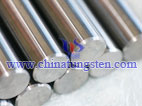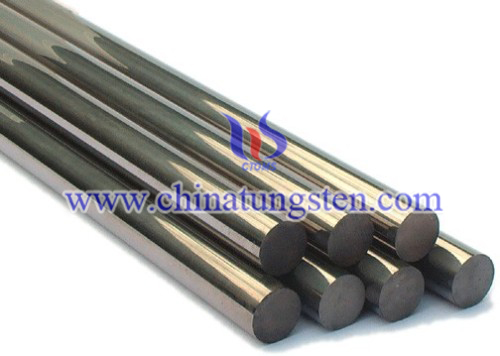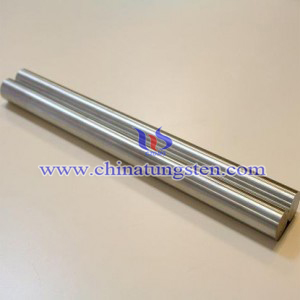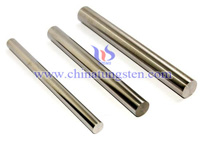Tungsten Alloy Swaging Rod & BrahMos
- Details
- Category: Tungsten Information
- Published on Monday, 18 November 2013 16:41
Tungsten alloy swaging rod is ideal materials for military ordance. Compared with tungsten alloy rod, tungsten alloy swaging rod has higher hardnsee, higher strength. Tungsten alloy swaging rod can be used as warhead for BrahMos.
BrahMos is a supersonic cruise missile that can be launched from submarines, ships, aircraft or land. It is a joint venture between Republic of India's Defence Research and Development Organisation (DRDO) and Russian Federation's NPO Mashinostroeyenia who have together formed BrahMos Aerospace Private Limited. The name BrahMos is a portmanteau formed from the names of two rivers, the Brahmaputra of India and the Moskva of Russia.
It is the world's fastest cruise missile in operation. The missile travels at speeds of Mach 2.8 to 3.0.[9] The land-launched and ship-launched versions are already in service, with the air and submarine-launched versions currently in the testing phase.[10] An air-launched variant of BrahMos is planned which is expected to come out in 2012 and will make India the only country with supersonic cruise missiles in their army, navy, and air force
Tungsten Alloy Swaging Rod & P-800 Oniks
- Details
- Category: Tungsten Information
- Published on Monday, 18 November 2013 16:28
Tungsten alloy swaging rod is ideal materials for military ordance. Compared with tungsten alloy rod, tungsten alloy swaging rod has higher hardnsee, higher strength. Tungsten alloy swaging rod can be used as warhead for P-800 Oniks.
The P-800 Oniks, also known in export markets as Yakhont , is a Russian/Soviet supersonic anti-ship cruise missile developed by NPO Mashinostroyeniya as a ramjet version of P-80 Zubr. Its GRAU designation is 3M55. Development officially started in 1983, and by 2001 allowed the launch of the missile from land, sea, air and submarine. The missile has the NATO reporting codename SS-N-26. It is reportedly a replacement for the P-270 Moskit, but possibly also for the P-700 Granit. The P-800 was reportedly used as the basis for the joint Russian-Indian supersonic missile BrahMos.
Anti-ship missiles penertrate armor of war ships by using kinetic energy. High density of tungsten alloy swaging rod improved penetration of P-800 Oniks for its high density.

Tungsten Heavy Alloy Manufacturer & Supplier: Chinatungsten Online - http://www.tungsten-alloy.com
Tel.: 86 592 5129696; Fax: 86 592 5129797
Email: sales@chinatungsten.com
Tungsten & Molybdenum Information Bank: http://i.chinatungsten.com
Tungsten News & Tungsten Prices, 3G Version: http://3g.chinatungsten.com
Molybdenum News & Molybdenum Price: http://news.molybdenum.com.cn
Tungsten Alloy Swaging Rod & C-802
- Details
- Category: Tungsten Information
- Published on Monday, 18 November 2013 16:18
Tungsten alloy swaging rod is ideal materials for military ordance. Compared with tungsten alloy rod, tungsten alloy swaging rod has higher hardnsee, higher strength. Tungsten alloy swaging rod can be used as warhead for C-802.
C-802 is a Chinese anti-ship missile first unveiled in 1989 by the China Haiying Electro-Mechanical Technology Academy (CHETA), also known as the Third Academy. Due to the Yingji-82 missile's small radar reflectivity, low attack flight path (only five to seven meters above the sea surface) and strong anti-jamming capability of its guidance system, target ships have a very small chance of intercepting the missile. The single shot hit probability of the C-802 is estimated to be as high as 98%. C-802 can be launched from airplanes, surface ships, submarines and land-based vehicles.
Anti-ship missiles penertrate armor of war ships by using kinetic energy. High density of tungsten alloy swaging rod improved penetration of C-802 for its high density.

Tungsten Heavy Alloy Manufacturer & Supplier: Chinatungsten Online - http://www.tungsten-alloy.com
Tel.: 86 592 5129696; Fax: 86 592 5129797
Email: sales@chinatungsten.com
Tungsten & Molybdenum Information Bank: http://i.chinatungsten.com
Tungsten News & Tungsten Prices, 3G Version: http://3g.chinatungsten.com
Molybdenum News & Molybdenum Price: http://news.molybdenum.com.cn
Tungsten Alloy Swaging Rod for C-803
- Details
- Category: Tungsten Information
- Published on Monday, 18 November 2013 16:08
Tungsten alloy swaging rod is ideal materials for military ordance. Compared with tungsten alloy rod, tungsten alloy swaging rod has higher hardnsee, higher strength. Tungsten alloy swaging rod can be used as warhead for C-803.
C-803 is a Chinese anti-ship missile based on the earlier YJ-82 model of the same class. It was designed as a supersonic successor to the subsonic YJ-82.
Specifications for the C-803 are as follows:
1.Length: 6 – 7 m
2.Weight: 850 – 1200 kg
3.Diameter: 0.36 m
4.Range: 280 – 300+ km (or more, depending on the launch platform)
5.Cruising altitude: 10 – 50 m for the initial target approach phase, 5 m for the final/terminal phase (~20 km from the target)
6.Speed:
Subsonic for initial target approach phase
Mach 1.3 for intermediary target approach phase (~30 km from the target)
Mach 1.7 for final target approach phase (~20 km from the target)
Mach 2 for terminal phase (~8 km from the target)
7. Propulsion: Solid-fuel rocket booster and turbojet engine
8.Warhead: 165 kg semi-armour-piercing
With the high density of tungsten alloy swaging rod, C-803 carried kinetic energy to penetrate armor of warships.

Tungsten Heavy Alloy Manufacturer & Supplier: Chinatungsten Online - http://www.tungsten-alloy.com
Tel.: 86 592 5129696; Fax: 86 592 5129797
Email: sales@chinatungsten.com
Tungsten & Molybdenum Information Bank: http://i.chinatungsten.com
Tungsten News & Tungsten Prices, 3G Version: http://3g.chinatungsten.com
Molybdenum News & Molybdenum Price: http://news.molybdenum.com.cn
Tungsten Alloy Swaging Rod for YJ-91
- Details
- Category: Tungsten Information
- Published on Monday, 18 November 2013 15:56
Tungsten alloy swaging rod is ideal materials for military ordance. Compared with tungsten alloy rod, tungsten alloy swaging rod has higher hardnsee, higher strength. Tungsten alloy swaging rod can be used as warhead for YJ-91.
YJ-91 is the Chinese version of the Kh-31. YJ is short for Ying Ji meaning eagle strike. After purchasing 200 Kh-31Ps from Russia, China decided to develop its own version, because the original Kh-31 missile did not fully satisfy Chinese requirements. The resulting YJ-91 missile was developed by Hongdu Aviation Industry Corporation, the same manufacturer of the Silkworm missile. The experience gained from YJ-91 also helped the engine development of another supersonic missile indigenously developed in China, YJ-12, which is sometimes non-Chinese sources confuse it with YJ-91, as both share the same origin for their propulsion systems.
With the high density of tungsten alloy swaging rod, YJ-91 carried kinetic energy to penetrate armor of warships.
Tungsten Heavy Alloy Manufacturer & Supplier: Chinatungsten Online - http://www.tungsten-alloy.com
Tel.: 86 592 5129696; Fax: 86 592 5129797
Email: sales@chinatungsten.com
Tungsten & Molybdenum Information Bank: http://i.chinatungsten.com
Tungsten News & Tungsten Prices, 3G Version: http://3g.chinatungsten.com
Molybdenum News & Molybdenum Price: http://news.molybdenum.com.cn
Tungsten Alloy Swaging Rod for DH-10
- Details
- Category: Tungsten Information
- Published on Monday, 18 November 2013 15:23
Tungsten alloy swaging rod is made of tungten alloy rod. Compared with tungsten alloy rod, tungsten alloy swaging rod has higher hardness and higher strength. Tungsten alloy swaging is used as warhead for DH-10. Higher density means more kinetic, highly improving penetration.
DH-10 is a cruise missile developed in the People's Republic of China by the Third Academy by CASIC.
According to Janes, the DH-10 is a second-generation land-attack cruise missile (LACM), integrated inertial navigation system, GPS, terrain contour mapping system, and digital scene-matching terminal-homing system. The missile is estimated to have a circular error probable (CEP) of 10 meters. In 2008, a Pentagon report estimated the range of the DH-10 as over 4,000 km and that from 50 to 250 missiles had been deployed.
DH-10 can penetrate stratum and destroy command centre and other military facilities hiding under the ground, for high density of tungsten alloy swaging rod.

Tungsten Heavy Alloy Manufacturer & Supplier: Chinatungsten Online - http://www.tungsten-alloy.com
Tel.: 86 592 5129696; Fax: 86 592 5129797
Email: sales@chinatungsten.com
Tungsten & Molybdenum Information Bank: http://i.chinatungsten.com
Tungsten News & Tungsten Prices, 3G Version: http://3g.chinatungsten.com
Molybdenum News & Molybdenum Price: http://news.molybdenum.com.cn
Tungsten Alloy Swaging Rod for CM-501G
- Details
- Category: Tungsten Information
- Published on Monday, 18 November 2013 15:09
Tungsten alloy swaging rod is made of tungten alloy rod. Compared with tungsten alloy rod, tungsten alloy swaging rod has higher hardness and higher strength. Tungsten alloy swaging is used as warhead for CM-501G. Higher density means more kinetic, highly improving penetration.
CM501G is a Chinese land attack missile first revealed during the 9th Zhuhai Airshow held in November 2012. Developed by China Aerospace Science & Industry Corporation(CASIC), CM-501G is also available in air and ship launched versions upon customers' requests, but only the land-based version made its public debut at the airshow.
The CM-501G missile has been claimed by many Chinese internet sources as the Chinese equivalent of the American NLOS-LS Netfires missile or the Israeli JUMPER missile, but the Chinese missile is much larger than the two western counterparts: in comparison to the 50 to 60 kg range of western missiles, CM-501G weighs around 150 kg, almost three times the weight of Netfires or JUMPER missiles. The 70 km+ range of the CM-501G is equal to that of the Netfires missile, and is longer than the 50km range of the JUMPER missile, and the warhead of CM-501G is around 40 kg.
CM-501G can penetrate armor and destroy armor vehicles, for high density of tungsten alloy swaging rod.

Tungsten Heavy Alloy Manufacturer & Supplier: Chinatungsten Online - http://www.tungsten-alloy.com
Tel.: 86 592 5129696; Fax: 86 592 5129797
Email: sales@chinatungsten.com
Tungsten & Molybdenum Information Bank: http://i.chinatungsten.com
Tungsten News & Tungsten Prices, 3G Version: http://3g.chinatungsten.com
Molybdenum News & Molybdenum Price: http://news.molybdenum.com.cn
Tungsten Alloy Swaging Rod for FL-7
- Details
- Category: Tungsten Information
- Published on Monday, 18 November 2013 15:02
Tungsten alloy swaging rod is made of tungten alloy rod. Compared with tungsten alloy rod, tungsten alloy swaging rod has higher hardness and higher strength. Tungsten alloy swaging is used as warhead for FL-7.
In addition to developing the C-101 and C-301 supersonic anti-ship missiles which are fairly large in size, China has developed FL-7 (FL: Fei Long, meaning Flying Dragon) supersonic anti-ship missile which can be carried on airplanes and warships. The Feilong-7 has an effective range of 32 kilometers and a speed of Mach 1.4. It has powerful anti-jamming capability and its supersonic flight makes terminal interception difficult. The warhead of the FL-7 can pierce solid armor and destroy large and medium-sized surface warships. This missile can be roughly considered as the supersonic counterpart of the subsonic C-704 anti-ship missile. The missile is powered by a liquid fuel rocket motor and a solid rocket booster, which is under the airframe at the rear.
FL-7 can penetrate the armor of ship, for high density of tungsten alloy swaging rod. Tungsten alloy swaging rod is idea materials for FL-7.

Tungsten Heavy Alloy Manufacturer & Supplier: Chinatungsten Online - http://www.tungsten-alloy.com
Tel.: 86 592 5129696; Fax: 86 592 5129797
Email: sales@chinatungsten.com
Tungsten & Molybdenum Information Bank: http://i.chinatungsten.com
Tungsten News & Tungsten Prices, 3G Version: http://3g.chinatungsten.com
Molybdenum News & Molybdenum Price: http://news.molybdenum.com.cn
Tungsten Alloy Swaging Rod for HJ-10
- Details
- Category: Tungsten Information
- Published on Monday, 18 November 2013 14:53
Tungsten alloy swaging rod is made of tungten alloy rod. Compared with tungsten alloy rod, tungsten alloy swaging rod has higher hardness and higher strength. Tungsten alloy swaging is used as warhead for HJ-10.
HJ-10 is a series of indigenously developed and highly classified (as of 2011) Chinese anti-helicopter / anti-tank missiles, they are the primary weapon of the CAIC WZ-10 attack helicopter. Many sources have claimed that this little-known missile is the Chinese equivalent of the AGM-114 Hellfire, although the details of the actual performance of the HJ-10 have yet to be released officially by the Chinese government or other credible sources to confirm such claims. Several derivatives of the HJ-10 have also been developed by China, they are all believed to be in limited service with the Chinese military for evaluation purposes.
Higher density means more kinetic energy. HJ-10 can penetrate armor and destroy armor vehicle, for high density of tungsten alloy swaging rod.

Tungsten Heavy Alloy Manufacturer & Supplier: Chinatungsten Online - http://www.tungsten-alloy.com
Tel.: 86 592 5129696; Fax: 86 592 5129797
Email: sales@chinatungsten.com
Tungsten & Molybdenum Information Bank: http://i.chinatungsten.com
Tungsten News & Tungsten Prices, 3G Version: http://3g.chinatungsten.com
Molybdenum News & Molybdenum Price: http://news.molybdenum.com.cn
Detecting Fake Gold Coins
- Details
- Category: Tungsten Information
- Published on Monday, 18 November 2013 14:27
Gold buyers, collectors and sellers could end up wasting their money buying a fake gold coin, unless they have the tools and knowledge to test whether or not a coin is genuine.
You don't have to be an expert to tell the difference between a real gold coin and a fake as long as you have the right tools to measure it and a reference book to check those measurements against.
1.Hold a magnet over the coin you are testing. If the coin sticks to the magnet, it has traces of steel or some other metallic metal in it meaning it is forged or plated and not solid gold.
2.Place the coin on a scale and record the exact weight. Look up the official weight of the coin in a reference book or on a reputable website. If the coin is more than a hundredth of a gram lighter or heavier, than the coin is suspect.
3.Measure the exact diameter of the coin with a caliper and compare that to the diameter listed in the reference book. If the diameter is off, even by a little, than the coin could be a counterfeit.
4.Examine the coin's surface more closely with a loupe. Look for any bubbles, depressions or scoring marks that indicate the coin was crudely made. A soapy film on the surface can also be a sign the coin is fake. Also check the date and mint mark against the ones listed in the reference book.
5.Drop the coin and listen to the sound it makes when it hits a hard surface. Gold coins have a distinct ringing sound, while fakes do not.
6.Using tongs, carefully drop the coin in a beaker of nitric acid. If the coin is pure gold, it will not react with the acid. However, if there are any base metals in the gold than those metals will dissolve. They will appear to be bubbling up as they corrode inthe acid.
Gold plated Tungsten Product Manufacturer & Supplier: Chinatungsten Online - http://paper-weight.cn/
Tel.: 86 592 5129696; Fax: 86 592 5129797
Email: sales@chinatungsten.com
Tungsten & Molybdenum Information Bank: http://i.chinatungsten.com
Tungsten News & Tungsten Prices, 3G Version: http://3g.chinatungsten.com
Molybdenum News & Molybdenum Price: http://news.molybdenum.com.cn



 sales@chinatungsten.com
sales@chinatungsten.com